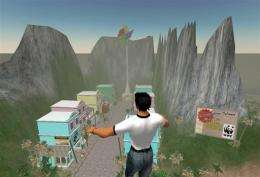Second Life finding new life

Linden Lab chief executive Mark Kingdon shakes his head when he sees news stories heralding the demise of former Internet darling Second Life.
Reporters that rushed into Second Life to cover cyber-events and portrayed the online fantasy realm as science fiction future come true have been pulling up stakes and tearing down the community they had embraced.
Well-known Silicon Valley gossip website Vallywag even started a death watch for Second Life.
"You read those stories; as CEO I have to shake my head," said Mark Kingdon, who last year took over for founder Philip Rosedale as chief executive of San Francisco-based Linden Lab, the company behind Second Life.
"The reality is that Second Life continues to grow; every second someone joins. Second Life is hopping."
The number of "active users" at Second Life has grown 25 percent since September last year, while the amount of time and money spent in the virtual world has climbed by similar percentages, according to Kingdon.
Linden Lab thinks the drubbing of its image is a rebound from the incredible hype it got during infancy.
"We are not called the darling anymore like Facebook or Twitter, but we are continuing to motor on at incredible levels," Kingdon said.
"Time will tell the story. We are a profitable business and we are growing."
Technology-loving "early adopters" flocked to Second Life, where they socialized in the forms of animated characters called "avatars" controlled by computer keystrokes and mouse clicks.
Second Life was accused of painting a misleading picture by touting the overall number of people that opened accounts without accounting for the fact that many people didn't stick around to homestead.
The number of people that have joined the virtual world since it was created in 1999 eclipsed 15 million last year.
The average number of people logged on to Second Life at any given time is about 70,000, according to Linden Lab.
Residents spent about 41.5 million hours total in Second Life in January, as opposed to the 28.3 million hours users spent in the virtual world the same month in 2008, according to Linden.
Voice capabilities were added last year so people can talk in-world instead of typing conversations.
"The array of things people do in Second Life has blossomed," Kingdon said. "One thing that has popped out as a killer application is business meetings."
Technology firms with workers spread around the world are increasingly using Second Life as an economical forum for meetings.
"There is something about that feeling of presence," said Karen Keeter, marketing director for digital convergence at IBM, which uses Second Life for gatherings.
"Being able to see yourself as this avatar standing there next to other people is just a feeling of immersion you don't get with other alternatives."
IBM's campus in Second Life features a picnic area with hammocks; a sculpture garden, and cafe for avatars to slip off and chat over faux coffee.
"People love that," Keeter said. "We create these environments that are like the lunch room. We get people there a half-hour early and the whole point is to mingle."
IBM is working with Linden to build a private conference area protected by a software "fire wall" for meetings focused on sensitive information best not discussed on the "public grid."
Kingdon downplays what he refers to as "an empty storefront syndrome" at Second Life.
An array of businesses that rushed in to sell virtual or real-world goods have abandoned the virtual world, leaving behind vacant faux buildings.
"Merchants in Second Life are doing well," Kingdon said. "We just bought two commerce sites last month because we see selling and buying of virtual good in Second Life is booming."
More than 1.3 million US dollars worth of transactions reportedly take place daily in Second Life, where the currency is the Linden dollar.
There are more than 15,000 merchants in Second Life selling snippets of computer code that become clothing, hair, art work or other items for avatars.
People spent 360 million dollars (US) in Second Life last year, according to Linden.
Schools continue to use Second Life for online classrooms and bands perform on in-world stages, albeit to sometimes meager audiences.
Linden is making avatar tools easier and "reworking the user experience," according to Kingdon.
"We have hired a world-class-team to lead the changes," Kingdon said. "You ain't seen nothing yet. A lot of work is going to be done in the next 9 to 12 months."
(c) 2009 AFP

















